小学定冠词the的练习题
小学英语冠词用法习题及答案
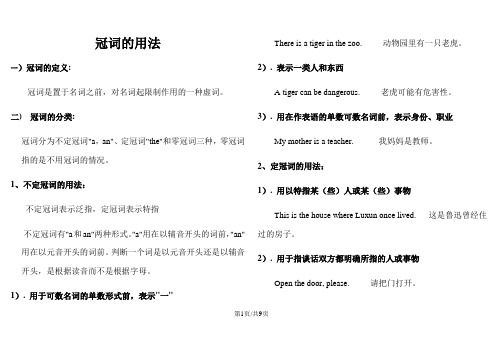
冠词的用法一)冠词的定义:冠词是置于名词之前,对名词起限制作用的一种虚词。
二) 冠词的分类:冠词分为不定冠词"a,an"、定冠词"the"和零冠词三种,零冠词指的是不用冠词的情况。
1、不定冠词的用法:不定冠词表示泛指,定冠词表示特指不定冠词有"a和an"两种形式。
"a"用在以辅音开头的词前,"an"用在以元音开头的词前。
判断一个词是以元音开头还是以辅音开头,是根据读音而不是根据字母。
1). 用于可数名词的单数形式前,表示"一"There is a tiger in the zoo. 动物园里有一只老虎。
2). 表示一类人和东西A tiger can be dangerous. 老虎可能有危害性。
3). 用在作表语的单数可数名词前,表示身份、职业My mother is a teacher. 我妈妈是教师。
2、定冠词的用法:1). 用以特指某(些)人或某(些)事物This is the house where Luxun once lived. 这是鲁迅曾经住过的房子。
2). 用于指谈话双方都明确所指的人或事物Open the door, please. 请把门打开。
第1页/共9页3). 用以复述上文提过的人或事物(第一次提到用“a或an”,以后再次提到用“the”)Once there lived a lion in the forest. Every day the lion askedsmallanimals to look for food for him.从前森林里住着一只狮子。
每天这只狮子要小动物们为他寻找食物。
4). 用在序数词和形容词最高级前January is the first month of the year. 一月份是一年当中的第一个月。
Shanghai is the biggest city in China. 上海是中国最大的城市。
小学三年级英语介词练习30题
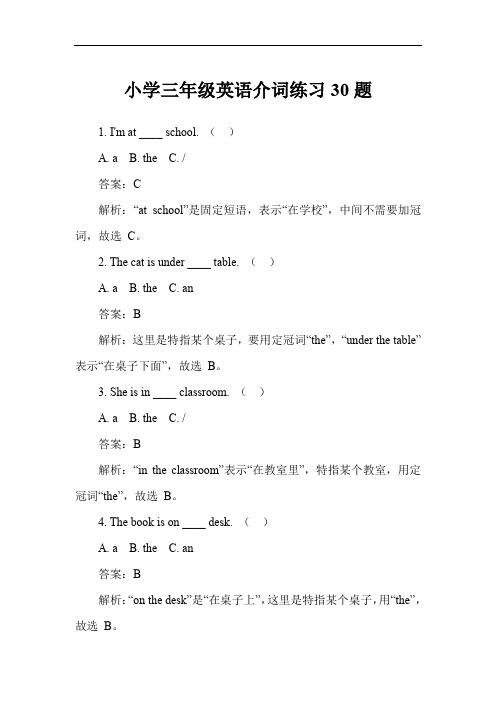
小学三年级英语介词练习30题1. I'm at ____ school. ()A. aB. theC. /答案:C解析:“at school”是固定短语,表示“在学校”,中间不需要加冠词,故选C。
2. The cat is under ____ table. ()A. aB. theC. an答案:B解析:这里是特指某个桌子,要用定冠词“the”,“under the table”表示“在桌子下面”,故选B。
3. She is in ____ classroom. ()A. aB. theC. /答案:B解析:“in the classroom”表示“在教室里”,特指某个教室,用定冠词“the”,故选B。
4. The book is on ____ desk. ()A. aB. theC. an答案:B解析:“on the desk”是“在桌子上”,这里是特指某个桌子,用“the”,故选B。
5. They are behind ____ tree. ()A. aB. theC. an答案:A解析:这里没有特指哪一棵树,用不定冠词,“tree”是辅音音素开头,用“a”,“behind a tree”表示“在一棵树后面”,故选A。
6. I have breakfast ___ the morning.A. inB. onC. at答案:A解析:“in the morning”是固定搭配,表示“在早上”。
7. We play football ___ the afternoon.A. inB. onC. at答案:A解析:“in the afternoon”表示“在下午”,是常用的时间介词短语。
8. My sister goes to bed ___ night.A. inB. onC. at答案:C解析:“at night”意思是“在晚上”。
9. They have a party ___ Sunday afternoon.A. inB. onC. at答案:B解析:当表示在具体某一天的上午、下午或晚上时,要用介词on ,“Sunday afternoon”是具体的某天下午,所以用on 。
(完整)小学英语冠词练习题
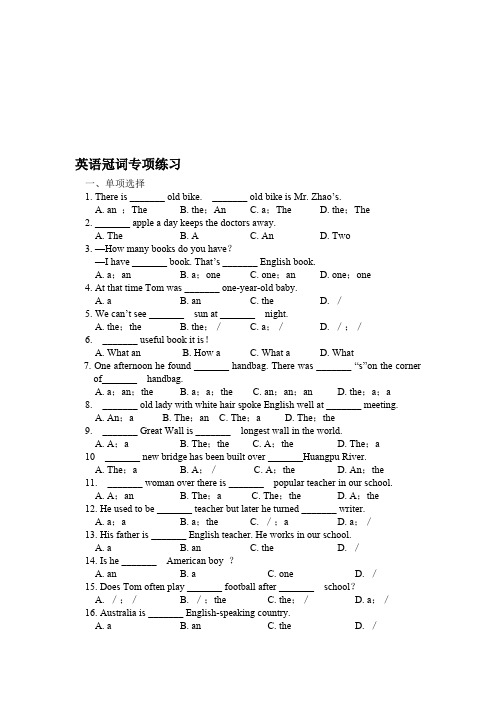
一、单项选择
A. an ;The
1. There is _______ old bike. _______ old bike is Mr. Zhao’s.
B. the;An
C. a;The
D. the;The
2. _______ apple a day keeps the doctors away.
A. a
B. an
C. the
D. /
hing at a time and All things in their being are good for somethin
17. She has _______ orange skirt. _______ skirt is nice.
A. a;The
D. What
7. One afternoon he found _______ handbag. There was _______ “s”on the corner
of_______ handbag.
A. a;an;the
B. a;a;the
C. an;an;an
D. the;a;a
8. _______ old lady with white hair spoke English well at _______ meeting.
A. a
B. an
C. the
D. /
25 The museum is quite far. It will take you half _______ hour to get there by
_______ bus.
A. an;/
B. an;a
C. a;/
D. /;/
中小学语法大全之冠词a_an_the 及专项练习题 -答案

专题六冠词(a an the )教学目标:1、掌握冠词的概念。
2、掌握定冠词和不定冠词的区别及用法。
3、掌握冠词与名词的搭配。
重点难点:1、重点:定冠词和不定冠词的区别。
2、难点:冠词与名词的搭配。
一、定义:冠词三兄弟a, an和the,它们的任务就是给名词“戴帽子”。
语法上,冠词是虚词,没有词义,用于名词前,帮助表明词义。
冠词三兄弟的分工各有不同,大家一定要记清楚,不要“张冠李戴”。
二、冠词分为两类:不定冠词:a/an定冠词:the●不定冠词a/an只能用于单数名词之前,表示“一”的意思或该名词的不特定性。
●定冠词the则强调该名词的特定性,表示“这”、“这些”等意思,在可数名词与不可数名词之前都能使用。
三、不定冠词a/an的用法:1、a用于以辅音音标开头的单词之前。
a book一本书 a woman一个女人2、an用于以元音音标开头(发音为元音开头)的单词之前。
an apple 一个苹果 an old man 一位老人an hour 一个小时 an egg一个鸡蛋3、当形容词修饰名词时,冠词要放在形容词的前面,这时用a或an取决于这个形容词的读音。
an English teacher一位英语老师 a red apple一个红苹果4、用于第一次提到的、不确定的人或物(可数名词)之前:There is ______dog outside the door 外面有一条狗。
Do you see ______man in red T-shirt?你有看到一个穿红T恤衫的男子吗?5、表示职业、身份:a lawyer一个律师 a doctor 一个医生 a student一位学生6、用于数字、量词之前:a hundred 一百 a lot of 许多 a pair of 一双7、用于一些固定词组中:have a rest休息 go for a walk 散步四、定冠词the的用法定冠词的一般用法:1、用于第二次谈到的人或物。
冠词与介词的用法讲解及练习

冠词与介词的用法讲解及练习(小学)一、冠词分类及其用法1.冠词的分类不定冠词:a 和an冠词定冠词:the零冠词:不使用冠词2.不定冠词的用法(1)a用在以辅音音素开头的单词前. A useful bookan用在以元音音素开头的单词前.An egg(2)基本用法:指人或事物的某一种类e.g. She is a girl. 她是女孩.This is a desk. 这是一张书桌.(3)泛指某人或者某物,但又不具体说明何人何物.e.g. I can see a kite. 我能看见一只风筝.A boy is in Grade 1. 一个男孩在一年级(4)表示“数量”,“有一”“每一”的意思.e.g. We have six classes a day. 我们一天上六节课.(5)表示“同一”,相当于the samee.g The two boys are of ______ age.Cotton of ______ kind was stored together.(6)用于某些物质名词或抽象名词前,表示“一种、一类、一份、一场、一阵”.e.g That is ____ green tea.They were caught in _____ heavy rain.a pleasure / a success/ a failure(7)用于专有名词前表示类似的一个或某一个.e.g ________ Mr. Li is asking to see you at the school gate.(8)否定比较级表达最高级意义时,常用借助于不定冠词a/ an. a/ an+比较级e.g. --- --What do you think of the film?----- Oh, I’ve never seen a worse one.----- How do you like Tom?------ I’m afraid that no one in my class has a cleverer brain than he.2.定冠词的用法(1)基本用法:“特指”.特指某(些)人或者某(些)事物,以便与其他的人或物有所区别.e.g. The book on the desk is Jim’s. 书桌上的那本书是吉姆的.The chairs are there. 椅子在那里.(2)指谈话双方都知道的人或事物.e.g. Where is the kite? 风筝在哪儿?(双方都知道指的是哪只风筝.)Open the door, please.请把门打开.(双方都知道要打开哪扇门.)(3)在叙述中,上文提到过的人或者事物,再次出现时.e.g. A:I can see a kite. 我看见一只风筝.B:where is the kite? 这个风筝在那里?(4)用在姓氏的复数名词前,表示“一家人”e.g. the Blacks 布来克一家(5)用在宇宙间独一无二的天体名词之前.e.g. the sun the sky the moon the earth(6)用在序数词和形容词最高级,及形容词only, very, same 前.e.g. I live on the second floor. 我住在二楼Skating is the best sport in winter. 滑冰是冬天最好的运动(7)用在某些建筑物和旅馆的名称之前.The Palace Museum The Summer Palace(8)用在表示乐器的名词之前.e.g. the violin the piano(9)用在一些习惯用语中e.g. in the dayin the morning / afternoon/ eveningthe day before tomorrow/ yesterdaythe next morning / week/ month/ yearin the sky/ water/ field/ countryin the darkin the rainin the distancein the middle (of)in the endon the wholeby the waygo to the theatre (cinema)3.零冠词的用法(1)名词前有了物主代词、指示代词、不定代词和“S”所有格时。
小学冠词的练习题
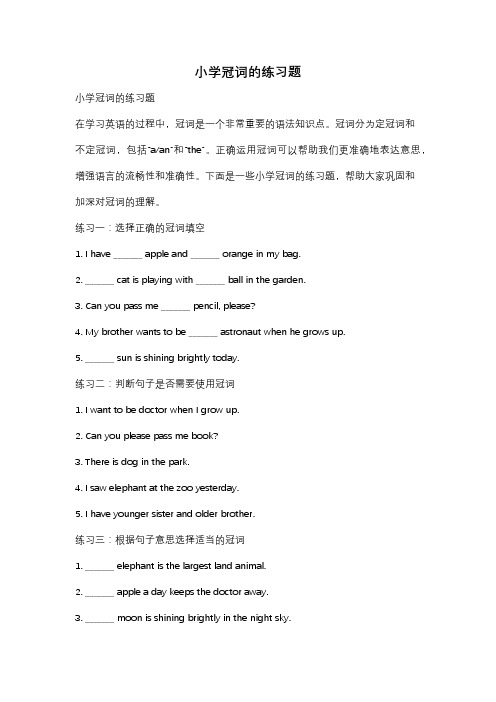
小学冠词的练习题小学冠词的练习题在学习英语的过程中,冠词是一个非常重要的语法知识点。
冠词分为定冠词和不定冠词,包括“a/an”和“the”。
正确运用冠词可以帮助我们更准确地表达意思,增强语言的流畅性和准确性。
下面是一些小学冠词的练习题,帮助大家巩固和加深对冠词的理解。
练习一:选择正确的冠词填空1. I have _______ apple and _______ orange in my bag.2. _______ cat is playing with _______ ball in the garden.3. Can you pass me _______ pencil, please?4. My brother wants to be _______ astronaut when he grows up.5. _______ sun is shining brightly today.练习二:判断句子是否需要使用冠词1. I want to be doctor when I grow up.2. Can you please pass me book?3. There is dog in the park.4. I saw elephant at the zoo yesterday.5. I have younger sister and older brother.练习三:根据句子意思选择适当的冠词1. _______ elephant is the largest land animal.2. _______ apple a day keeps the doctor away.3. _______ moon is shining brightly in the night sky.4. I have _______ idea for our school project.5. Can you please give me _______ glass of water?练习四:填入适当的冠词1. I have _______ interesting story to tell you.2. There is _______ beautiful flower in the garden.3. My father is _______ engineer.4. Can you please pass me _______ salt?5. _______ cat is sleeping on _______ chair.练习五:根据上下文填入适当的冠词1. I saw _______ dog on _______ street yesterday.2. My friend has _______ pet rabbit. _______ rabbit is very cute.3. _______ sun rises in _______ east and sets in _______ west.4. I have _______ red pen and _______ blue pen. _______ red pen is mine.5. _______ elephant is _______ largest animal on land.这些练习题涵盖了冠词的基本用法,通过练习可以帮助学生更好地理解和掌握冠词的使用规则。
小学英语语法--冠词语法精细讲解及对应练习题
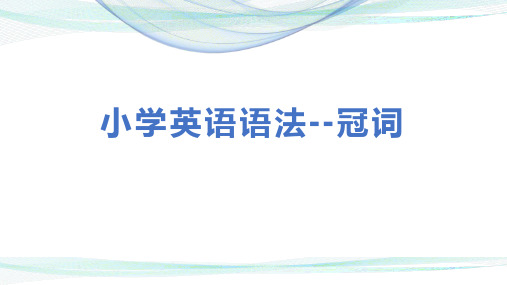
A.a
B.an
C. the
D./
5 . To n y h a s _ ___ egg a n d s o m e ve g e t a b le s f o r b r e a kfast.
A.a
B.an
C.some
D.any
冠词习题练一练
6. I have____French stamp. The stamp is beautiful.
at school 上学 at table 在吃饭 in bed (睡、病、躺)在床上 in hospital 住院 by sea 乘船 in front of 在……前面(外部) on earth 究竟
冠词习题练一练
一、填写适当的冠词 _____ball _____book _____apple _____story _____Earth ______egg _____chair _____sun _____pear _____onion 二、用适当的冠词填空 1.___sun is very hot. 2. Can I have ___ apple? 3. Do you want to eat ___ egg? 4. I want to buy ___ new car. 5. Mommy likes to read ___ story. 6. I have ___ blue ball. 7. He broke ___ chair. 8. She reads ___ book in class. 9. I have ___ apple and ___ pear for lunch.
冠词习题练一练 三.圈出正确的冠词 1. Sue had to hurry to catch the / an bus. 2. Clive and Julian played guitar in a / an band. 3. Petey buried an / a bone in Nana's backyard. 4. My school won the / an first place prize for selling candles! 5. I want to ride my bike to the / a friend's house. 6. The / An new computer we bought has iTunes on it. 7. My sneakers have a / an orange stripe on the side. 8. Legos are fun to play with the / a friend or two. 9. We watched a TV show being filmed in a / the town. 10. I watched as mom put the Cream-of-Wheat into a / an pot.
小学英语冠词专题练习

英语专项练习-------- 冠词练习(B)’s orange, orange is orange.,the ,The ,a(C)’s your favourite sports high jump.C./( ) time do you listen to radioB./( ) we meet at gate of park at 7:30.,the ,a ,a( ) basketball yoursC./( )6. Young Pioneers are helping old woman. ,the ,an ,/( ) at ’s big egg.,a ,a ,an( ) want to buy English book( ), students are cleaning classroom.,a ,the ,an( )’s sitting in apple tree.C./( ) you got ruler( ) hasn’t got dog in bag.,the ,the ,an( ) lefe at third hotel is on right.,the ,the ,a( )’s money.( ) I take bus to the Garden Hotel( ) you want orange coat.( ) we watch TV in evening.C./( ) you like glass of milk( ) Children have class,/ ,a ,the( ) is lady doingShe’s reading in sun.,a ,the ,the( )’s nice I have look,a ,the ,a( ) can see sun in afternoon.,the ,/ ,/( ) is some bread on plate.( ) you got clock( ) at girl. She’s eating big apple. ,the ,a ,an( ) of athlete is my friend.( )27. People’s Park is over there.( ) clothes are same.( )29. yellow sweater is mine.( )’s athlete.( )31.She swims for _____hour every morning.A. a( ) father is _____office worker.A. a( ) is ___Australian girl. She is ___pupil.A. an a an a( ) is ____first day of a week.A. a( ) is ___empty box on the plate.A. a( )’s ______old man under the man is my grandfather.The B./ The C. a A( ) you play ______violinA. /B. theC. a( ) White is from ______USA. She is _____ American./ an a( ) there _____ “e” in the word “meat”A. a C. an( ) Brown has not _______long hairA. /B. a C, the( ) eggs are they _______eagle’s .A. An( ) Meihua live on ______third floorA, an B. the( ) is ______ fifth day of a weekB. /( ) you like listen to ______ radio and listen to ______ musicA ./ the B. the the C. / /( )45 Janet has two friends. One is American, _____other is Australian.A. /B. theC..a( )46. We are going to climb ______mountain next Sunday .A. /B. theC. a( )47. Are the trousers _______same or _____differerntA. the theB. / the /( ) don’t talk in ______ class .A .the B. / C. a( ),don’t read in ______bed and in ________ sun .A. / theB. the / the( ) are many shops in _______New Street .A. the B / C. this( ) that _______ toy animal Yes ,_____animal is mine .A .a the B. an the C. a the( )52. _______ young lady is our maths teacher .A. AB. T heC. /( )53.Look! some birds are flying in________ sky .A. /B. aC. the( )’s _________ big app le .________apple is mine.A. an TheB. a TheC. / an( ) is your father ______ man in brown .A. AB. TheC. /( ) are in ________same grade ,but in ________ different classes . the B. the / C./ the( )’s ______Chinese ,her friend is _________ American girl .A. / anB. / , /C. a an( )58. Let’s meet at eight in ________ .morningA. thisB. theC. /( ) we go there by ______ bike Sorry ,I can’t ride ______ bikes .A. the /B. / theC. / /( )60. Can you see _____ orange box Sorry ,I can only see _____ empty yellow boxes .A . the anB . an an C. an /( )61.Is Mr Smith _______ art teacher of your schoolA. an C. the( ) read aloud _____ first lesson .A. aB. an( ) is _____ empty bottle .A. aB. an( )’s grandm other is _____ old worker.A. aB. an( ) is _____ shirt in the box .A. aB. an( ) are in _____same class .( ) is _____ Australian boy .A. aB. an( ) sun is in the sky .A. AB. An( ) out _______”e” from egg .A. aB. an( ) is Mr Black _____ tall one.A. aB. an( )’s _____ name of this dog Browny .A. aB. an( )’t read in_______ bed .A. aB. /( ) goes fishing for ________ hour every day .A. aB. an( ) father is _______ office worker .A. aB. an( ) is _____ big apple tree in front of the house .A. aB. an( )’s in _____ second picture A dog .A. aB. an( ) on _______TV ,please .A. aB. an( )’t talk in ______ class .A. /B. an( ) brother likes singing ______ lot .A. aB. an( ) is _____piece of paper on the desk .A. aB. an( ) ____ lot .A. aB. an( ) right at _______third crossing .A. aB. an( ) uncle lives on ______ground floor .( )’s go to school by -_________ bike .A. /B. an( ) play ____ piano once again .A. aB. an( ) like play ____ football very much .A. /B. an( ) black car is ______ English car .A. aB. an( )’s that boy in ______brown jacket .A. aB. an( ) is _____ e-mail address .A. aB. an( ) sister is ___pupil of this school .A. aB. an( ) there a bookshop in ______Hill StreetA. /B. an( )92. Can you see ________ sun in the skyA. a( )93. Kate is _______ eleven—year—old girl( )94. We always say: “Lady _____first” .A. /( ) wash your hands ______first.B./( )’s only child in his family.B./( )97. old man is my uncle.B./( ) is pen. Tt’s orange pen. an B./ an an( )’t read in sun.( )’s time to go to school.B./。
小学英语冠词的练习题.doc
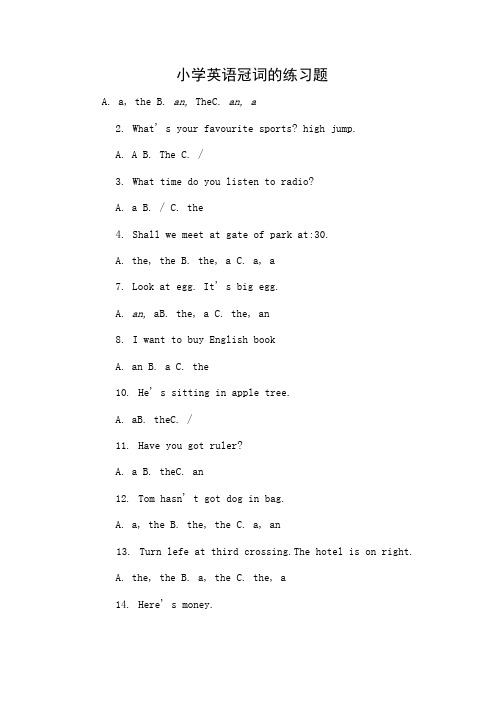
小学英语冠词的练习题A. a, theB. an, TheC. an, a2.What' s your favourite sports? high jump.A. AB. TheC. /3.What time do you listen to radio?A. aB. /C. the4.Shall we meet at gate of park at:30.A. the, theB. the, aC. a, a7.Look at egg. It' s big egg.A. an, aB. the, aC. the, an8.I want to buy English bookA. anB. aC. the10.He' s sitting in apple tree.A. aB. theC. /11.Have you got ruler?A. aB. theC. an12.Tom hasn' t got dog in bag.A. a, theB. the, theC. a, an13.Turn lefe at third crossing.The hotel is on right.A. the, theB. a, theC. the, a14.Here' s money.15.Can I take No. 2bus to the Garden Hotel?A. theB. aC. an16.Do you want orange coat.A. theB. anC. a17.Sometimes we watch TV in evening.A. aB. theC. /18.Would you like glass of milk?A. theB. anC. a19.Are Children have class?A. the, /B. the, aC. the, the20.What is lady doing?sun.A. the, aB. the, theC. a, the21.That' s nice picture. May I have look?A. the, a C. a, a22.We can see sun in afternoon.A. the, theB. a, /C. the, /23.There is some bread on plate.A. anB. aC. the 英语专项练习------------ 冠词练24.Have you got clock?25.Look at girl. She' s eating big apple.A. a, theB. the, aC. the, an26.One of athiete is my friend.A. aB. theC. an28.These clothes are same.A. aB. theC. an30.He' s athiete.A. aB. anC. the31.She swims for _________ hour every morning.A. aB. theC. an32.My father is ________ office worker.A. aB. anC. the33.Ann is ____ Australian girl. She is _________ pupil.A. anaB. ananC. aa34.Sunday is _______ first day of a week.A. aB. theC. an35.There is ____ empty box on the plate.A. aB. theC. an36._________ There' s___________________________ o ld manunder the tree. _____ man is my grandfather.A. anTheB. / TheC. a A37.Can you play __________ v iolin ?A. /B. theC. a38.Miss White is from ____________ U SA. She is _________ American.A. the /B. the anC. thea39.Is there ________ “e" in the word “meat" ?A. aB. theC. an40.Mrs Brown has not ______________ long hairA. /B. a C, the41.Whose eggs are they ? ________________eagle' s .A. AnB. AC. The42.Does Meihua live on __________ t hird floor ?A, anB. theC. a43.Which is ________ fifth day of a week ?A. theB. /C. an44.Do you like listen to __________ radio and listento ________ music ?A . / the B. the theC. / /4Janet has two friends. One is American,_____ other is Australian.A. /B. theC. . a46.We are going to climb ____________ mountain nextSunday .47.Are the tro users _______________ same or _____ differernt ?A. the theB. / theC. the /48.Please don' t talk in ____________ c lass .A . the B. / C. a49.Kate, don' t read in _________ bed and in ___________ sun .A. / theB. the /C. the the50.There are many shops in ____________ New Street .A. the B /C. this51.Is that _________ toy animal ?Yes , __________ animal is mine .A .atheB. an theC. a the52.________ y oung lady is our maths teacher .A. AB. T heC. /53.Look! some birds are flying in ______________ sky .A. /B. aC. the54.That' s ____________big apple . ___________ a pple is mine.A. an TheB. a TheC. / an55.Which is your fat her ? _________ man in brown .A. AB. TheC. /56.We are in __________ same grade , but in ____________ different classes .A. the theB. the /C. / the57.She' s ________ Chinese , her friend is _____________ American girl .A. / anB. / , /C. aan58.Let' s meet at eight in ________________ . morningA. thisB. theC. /59.Shall we go there by ____________ bike ? Sorry , I can' t ride __________ bikes .A. the /B. / theC. //60.Can you see ________ orange box ? Sorry , I canonly see _______ empty yellow boxes .A . the anB . an an C. an /61.Is Mr Smith ____________ art teacher of your school ?A. anB. aC. the62.Please read aloud ________ first lesson .A. aB. anC. the63.This is ______ empty bottle .64.Kate' s grandmother is __________ old worker.A. a B.anC. the65.There is shirt in the boxA. aB.anC.the66. We arein same class .A. aB.anC.the67.Jack is _______ Australian boy .A. aB. anC. the68._______ sun is in the sky .A. AB. AnC. The69.Take out __________ " e" from egg .A. aB. anC. the70.Which is Mr Black ? _________ tall one.A. aB. anC. the71.What' s _______ name of this dog ? Browny .A. aB. anC. the72.Don' t read in ___________ b ed .A. aB. /C. the73.He goes fishing for _____________ hour every day .A. aB. anC. the74.His father is office worker .75.There is _______ big apple tree in front of the house .A. aB. anC. the76.What' s in _______ second picture ? A dog .A. aB. anC. the77.Turn on __________ TV , please .A. aB. anC. the78.Don' t talk in __________ class .A. /B. anC. the79.My brother likes singing ___________ lot .A. aB. anC. the80.There is ______ piece of paper on the desk .A. aB. anC. the81.Thanks ______ lot .A. aB. anC. the82.Turn right at ___________ third crossing .A. aB. anC. the83.My uncle lives on __________ ground floor .A. aB. anC. the84.Let' s go to school by - _______________ bike .A. /B. anC. the85.Please play _______ piano once again .A. aB. anC. the86.We like play ______ football very much .A. /B. anC. the87.The black car is _________ English car .A. aB. anC. the88.Who' s that boy in ___________ b rown jacket .A. aB. anC. the89.This is ______ e-mail address .A. aB. anC. the90.My sister is ______ pupil of this school .A. aB. anC. the91.Is there a bookshop in ____________ Hill Street?A. /B. anC. the92.Can you see _____________ sun in the sky ?A. aB. anC. the93.Kate is ___________ eleven一year一old girl ?A. anB. aC. the94.We always say: “Lady __________ first" .A. /B. anC. the95.Please wash your hands __________ first.A. aB. /C. the96.He' s only child in his family.A. aB. /C. the97.old man is my uncle.A. aB. /C. the98.This ispen. Tt' sorange pen.A. a anB. / anC. the an99.Don' t read insun.A. aB. anC. the100.It' s time to go to school.A. aB. /C. the冠词一、定义冠词是一种虚词,本身不能单独使用,也没有词义,它用在名词的前面,帮助指明名词的含义。
小学英语人教(PEP)六年级下册小学定冠词和不定冠词练习题.docx

小学英语人教( PEP)六年级下册小学定冠词和不定冠词练习题1.在空格内填上 a 或 an1._____ear2.______actor3. _____hen4.______toy5. ______university6. ______elephant7.______hat8.______umbrella9.______rabbit10.______idea11.______hour 12_______ honest boy 13.______interesting book 14.______easy question15.______orange dress16_______apple pie17_______X-ray machine18.______ice cream2.用 a,an,the或“/填”空1.________Washington is _______capital of ________United States of America.2.There is _________” A” on his paper.3. I ate ______apple .It’ s _______red apple.4._______tall man over there is my boss.5._______earth moves around sun.6.No news is ________good news.7.Have you visited Great Wall?8.They often play football after school.9.Children need love and attention.10.Are there any birds in sky?11.student in the third row is tallest in our class.12.Did you have breakfast this morning?13.Mr.White will go to Tokyo by air.14.By way,do you know old woman in glasses?3.选择填空1.Mom tells her little daughter old story every night.A. aB. /C. anD. theputer on the table is Susan’s.A. AB. AnC. TheD. /3.There is map of the world on wall.map is mine.A. a, a, AB. a, the, TheC. the, the, TheD. the, the, A4.Whites live on floor.A. /, threeB. A, thirdC. The, thirdD.The, the third5.Spring comes after winter.A. /, /B.The, /C.The, theD.A, the6.I bought shoes yesterday.shoes are very beautiful.A. a, TheB. a pair of, TheC. the, TheD. a pair, The pair7.He was soldier in the Second World War.A. aB. anC. theD. /8.She can play and.A. the tennis, the guitarB. tennis, guitarC. the tennis, guitarD. tennis, the guitar9.I can see moon and clouds in the sky.A. the, aB. a, aC. the, /D. the, the10.“c” is in“cat“.s” is in“sat.”A. An, AnB. An, AC. A, AD. A, An11.Tian ’anmen Square is in Beijing.A. /, /B. A, /C. The, /D. /, the12.—Can you tell me nearest bookshop?—Go straight and turn right at_______third crossing, and you will see it.A. the, aB. the, theC. a, theD. the, /冠词冠词分为不定冠词( a, an),定冠词( the),和零冠词。
冠词aanthe相关题目
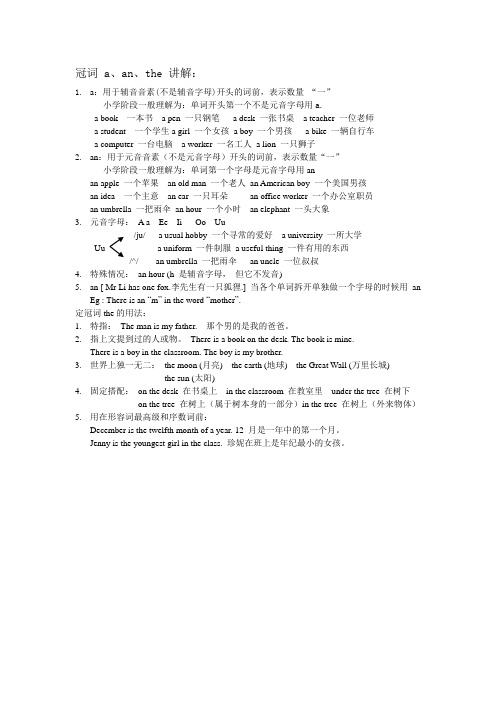
冠词 a、an、the 讲解:1.a:用于辅音音素(不是辅音字母)开头的词前,表示数量“一”小学阶段一般理解为:单词开头第一个不是元音字母用a.a book 一本书 a pen 一只钢笔 a desk 一张书桌 a teacher 一位老师a student 一个学生a girl 一个女孩a boy 一个男孩 a bike 一辆自行车a computer 一台电脑 a worker 一名工人a lion 一只狮子2.an:用于元音音素(不是元音字母)开头的词前,表示数量“一”小学阶段一般理解为:单词第一个字母是元音字母用anan apple 一个苹果an old man 一个老人an American boy 一个美国男孩an idea 一个主意an ear 一只耳朵an office worker 一个办公室职员an umbrella 一把雨伞an hour 一个小时an elephant 一头大象3.元音字母:A a Ee Ii Oo Uu/ju/ a usual hobby 一个寻常的爱好 a university 一所大学Uu a uniform 一件制服a useful thing 一件有用的东西/^/ an umbrella 一把雨伞an uncle 一位叔叔4.特殊情况:an hour (h 是辅音字母,但它不发音)5.an [ Mr Li has one fox.李先生有一只狐狸.] 当各个单词拆开单独做一个字母的时候用anEg : There is an “m” in the word “mother”.定冠词the的用法:1.特指:The man is my father. 那个男的是我的爸爸。
2.指上文提到过的人或物。
There is a book on the desk. The book is mine.There is a boy in the classroom. The boy is my brother.3.世界上独一无二:the moon (月亮) the earth (地球) the Great Wall (万里长城)the sun (太阳)4.固定搭配:on the desk 在书桌上in the classroom 在教室里under the tree 在树下on the tree 在树上(属于树本身的一部分)in the tree 在树上(外来物体)5.用在形容词最高级和序数词前:December is the twelfth month of a year. 12 月是一年中的第一个月。
小学定冠词the的练习题
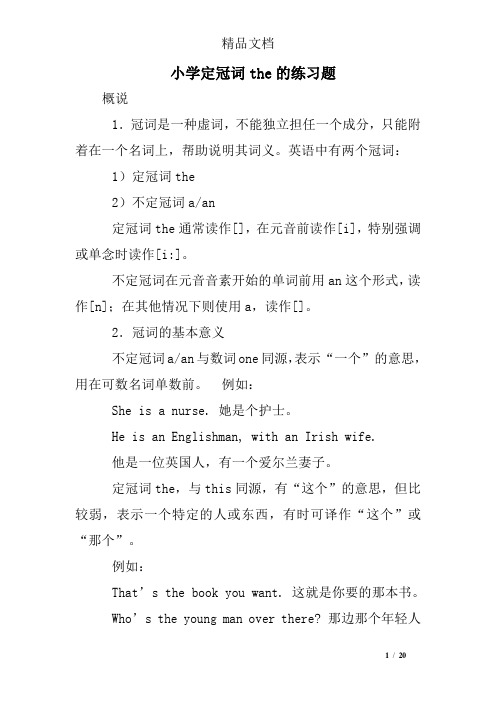
小学定冠词the的练习题概说1.冠词是一种虚词,不能独立担任一个成分,只能附着在一个名词上,帮助说明其词义。
英语中有两个冠词:1)定冠词the2)不定冠词a/an定冠词the通常读作[],在元音前读作[i],特别强调或单念时读作[i:]。
不定冠词在元音音素开始的单词前用an这个形式,读作[n];在其他情况下则使用a,读作[]。
2.冠词的基本意义不定冠词a/an与数词one同源,表示“一个”的意思,用在可数名词单数前。
例如:She is a nurse. 她是个护士。
He is an Englishman, with an Irish wife.他是一位英国人,有一个爱尔兰妻子。
定冠词the,与this同源,有“这个”的意思,但比较弱,表示一个特定的人或东西,有时可译作“这个”或“那个”。
例如:That’s the book you want. 这就是你要的那本书。
Who’s the young man over there? 那边那个年轻人是谁?但在很多情况下,“这”或“那”这类词在译文中并不出现。
例如:Put it on the table. 把它放在桌上。
Shut the door, please. 请把门关上。
3.特指和泛指一般来说,名词有特指和泛指两种情况,请比较下面的句子:A gentleman is asking to see you. 有位先生要求见你。
Ask the gentleman to come in. 请那位先生进来。
在特指时一般前面要加定冠词,而泛指时则有三种情况: 1)在可数名词单数前加不定冠词。
例如:She sent me a postcard 她寄给我一张明信片。
2)在可数名词复数前可不加冠词,可使用some, any 这类词。
例如:These are new words. 这些是生词。
She sent me some flowers. 她送给我一些花。
3)在不可数名词前多不加什么,有时也可加some, any等。
小学英语名词练习题冠词
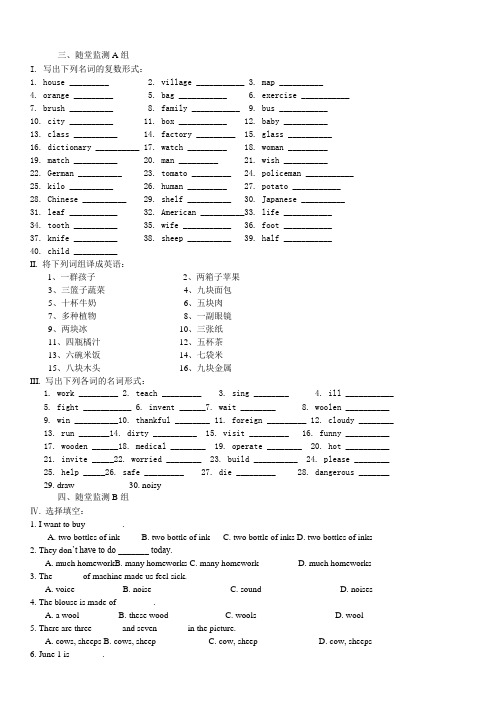
三、随堂监测A组I. 写出下列名词的复数形式:1. house _________2. village ___________3. map __________4. orange _________5. bag ___________6. exercise ___________7. brush __________ 8. family ___________ 9. bus ___________10. city __________ 11. box ___________ 12. baby __________13. class __________ 14. factory _________ 15. glass __________16. dictionary __________ 17. watch _________ 18. woman _________19. match __________ 20. man _________ 21. wish __________22. German __________ 23. tomato _________ 24. policeman ___________25. kilo __________ 26. human _________ 27. potato ___________28. Chinese __________ 29. shelf __________ 30. Japanese __________31. leaf ___________ 32. American __________33. life ___________34. tooth __________ 35. wife ___________ 36. foot ___________37. knife __________ 38. sheep __________ 39. half ___________40. child __________II. 将下列词组译成英语:1、一群孩子2、两箱子苹果3、三篮子蔬菜4、九块面包5、十杯牛奶6、五块肉7、多种植物8、一副眼镜9、两块冰10、三张纸11、四瓶橘汁12、五杯茶13、六碗米饭14、七袋米15、八块木头16、九块金属III. 写出下列各词的名词形式:1. work _________2. teach _________3. sing ________4. ill ___________5. fight ___________6. invent ______7. wait ________8. woolen __________9. win __________10. thankful ________ 11. foreign _________ 12. cloudy ________13. run _______14. dirty __________ 15. visit _________ 16. funny __________17. wooden ______18. medical ________ 19. operate ________ 20. hot __________21. invite _____22. worried ________ 23. build __________ 24. please ________25. help _____26. safe _________ 27. die _________ 28. dangerous _______29. draw ________ 30. noisy ________四、随堂监测B组Ⅳ. 选择填空:1. I want to buy ________.A. two bottles of inkB. two bottle of inkC. two bottle of inksD. two bottles of inks2. They don’t have to do _______ today.A. much homeworkB. many homeworksC. many homeworkD. much homeworks3. The ______ of machine made us feel sick.A. voiceB. noiseC. soundD. noises4. The blouse is made of ________.A. a woolB. these woodC. woolsD. wool5. There are three ______ and seven ______ in the picture.A. cows, sheepsB. cows, sheepC. cow, sheepD. cow, sheeps6. June 1 is _______.A. children’s dayB. children’s DayC. Children’s DayD. Children’s day7. ______ room is next to their parents’.A. Kate’s and Joan’sB. Kate’s and JoanC. Kate and Joan’sD. Kate and Joan8. Miss Green is a friend of _______.A. Mary’s mother’sB. Mary’s motherC. Mary mother’sD. mother’s of Mary9. Tom is ______. He will come to see me.A. my a friendB. a friendC. mine friendD. a friend of mine10. Sheep _______ white and milk _______ also white.A. is, areB. are, isC. is, isD. are, are11. I’d like to have a glass of milk and _______.A. two breadsB. two pieces of breadsC.two pieces of breadD. two piece of bread12. It’s a long ______ to Paris. It’s two thousand kilometers.A. streetB. roadC. wayD. end13. Many ______ are singing over there.A. womanB. womenC. girlD. child14. He bought _______.A. two pairs of shoesB. two pair of shoesC. two pairs of shoeD. two pair ofshoe15. Mr. White has three _______.A. childB. childrenC. childsD. childrens16. Beijing is one of the biggest _______ in the world.A. citysB. cityC. cityesD. cities17. --- Where’s Mr. White? --- He’s in _______.A. the room 202B. Room 202C. the Room 202D. room 20218. Shops, hospitals and schools are all _______.A. placesB. homesC. roomsD. buildings19. Every morning Mr. Smith takes a _______ to his office.A. 20 minutes’ walksB. 20 minute’s walkC. 20-minutes walkD. 20-minute walk20. ---Are these ______? --- No, they aren’t. They’re _______.A. sheep, cowsB. sheep, cowC. sheeps, cowD. sheeps, cows21. There are many ______ in the fridge.A. fishB. fruitC. eggsD. bread22. --- Whose room is this? --- It’s _______.A. Li MingB. Li Ming’sC. Li MingsD. Li Mings’23. Here are ______ for you, Sue.A. potatosB. some potatoesC. three tomatosD. some tomato24. Here are some birthday cards with our best ______ for her.A. wishB. hopeC. wishesD. hopes25. I always go to that ______ to buy food on Sunday.A. shopB. parkC. zooD. garden26. What’s the Chinese for “ PRC”?A. 中国人民解放军B. 中华人民共和国C. 联合国D. 中国共产党27. Sam gave Ann some _______ to look after Polly while he was away.A. picture-booksB. inventionsC. instructionsD. messages28. --- Which of the following animals lives only in China? --- The ________.A. monkeyB. elephantC. pandaD. cat29. ______ room is on the 5th floor.A. Lucy and LilyB. Lucy and Lily’sC. Lucy’s and LilyD. Lucy’s and Lily’s30. The third month of the year is _______.A. MarchB. JanuaryC. FebruaryD. April31. Mum, I’m quite thirsty. Pl ease give me ________.A. two orange B .two bottle of oranges C. two bottles of orange D. two bottles of oranges32. How wonderful! The ______ is made of _______.A. house, glassB. house, glassesC. houses, glassD. houses, glasses33. I met some ______ in the park and talked with them the other day.A. JanpanesesB. AmericanC. ChinesesD. English34. _______ is the best time for planting trees.A. SummerB. WinterC. SpringD. Autumn35. Tom was badly hurt in the match. They carried him to the ______ as quickly as possible.A. bankB. post officeC. shopD. hospital36. There are two ______ in the room.A. shelfB. shelfsC. shelfesD. shelves37. There are seven ______ in a week.A. yearsB. monthsC. daysD. minutes38. My father is a ______. He works in a hospital.A. teacherB. doctorC. farmerD. writer39. It’s very cold today. Why don’t you put on your ______?A. watchB. shirtC. sweaterD. glasses40. --- Excuse me, are you ______? --- Yes, I’m from ________.A. Japan, JapaneseB. China, ChineseC. England, EnglishD. American, AmericaV. 各地中考题选编:1. --- Where is Tom? --- He’s left a ______ saying that he has something i mportant to do.A. excuseB. messageC. exerciseD. news2. There is no ______ in the bus so we have to wait for another bus.A. roomB. a roomC. roomsD. seats3. --- Would you like some ______? --- Oh, yes. Just a little.A. pearsB. orangesC. sugarD. apples4. You can find the following INSTRUCTIONS on _______. KEEP IN A COLD PLACEA. foodB. moneyC. clothesD. books5. Mr. Green has lived in the _____ hotel since he came to China.A. five-starB. five-starsC. five star’sD. five stars6. She was born in Wuhan, but Beijing has become her second _______.A. homeB. familyC. houseD. place7. --- What’s the _____ today? --- It’s June 26.A. dayB. dateC. timeD. hour8. English is spoken as a first language in ______.A. the USAB. IndiaC. JapanD. China9. ______ comes from cows.A. WoolB. ChickenC. PorkD. Milk10. Which of the following does paper burn in?A. 2coB. 2NC. 2OD. 2H11. Let the children go away. They’re making too much ______ here.A. noiseB. voiceC. noisyD. sounds12. ______ comes from sheep and some people like eating it.A. WoolB. PorkC. MuttonD. Milk13. --- Oh, there isn’t enough ______ for us in the lift.--- It doesn’t matter, let’s wait for the next.A. groundB. floorC. placeD. room14. _______ is the biggest city in China.A. BeijingB. ShanghaiC. GuangzhouD. Kunming冠词重点知识归纳及讲解(一)概说1.冠词是一种虚词,不能独立担任一个成分,只能附着在一个名词上,帮助说明其词义。
小学英语冠词练习题
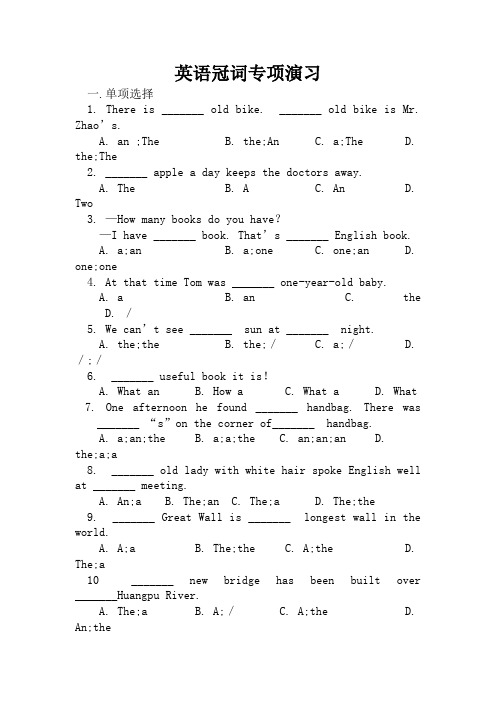
英语冠词专项演习一.单项选择1. There is _______ old bike. _______ old bike is Mr. Zhao’s.A. an ;TheB. the;AnC. a;TheD.the;The2. _______ apple a day keeps the doctors away.A. TheB. AC. AnD.Two3. —How many books do you have?—I have _______ book. That’s _______ English book.A. a;anB. a;oneC. one;anD. one;one4. At that time Tom was _______ one-year-old baby.A. aB. anC. theD. /5. We can’t see _______ sun at _______ night.A. the;theB. the;/C. a;/D./;/6. _______ useful book it is!A. What anB. How aC. What aD. What7. One afternoon he found _______ handbag. There was_______ “s”on the corner of_______ handbag.A. a;an;theB. a;a;theC. an;an;anD.the;a;a8. _______ old lady with white hair spoke English wellat _______ meeting.A. An;aB. The;anC. The;aD. The;the9. _______ Great Wall is _______ longest wall in the world.A. A;aB. The;theC. A;theD. The;a10 _______ new bridge has been built over_______Huangpu River.A. The;aB. A;/C. A;theD.An;the11. _______ woman over there is _______ popular teacher in our school.A. A;anB. The;aC. The;theD.A;the12. He used to be _______ teacher but later he turned_______ writer.A. a;aB. a;theC. /;aD.a;/13. His father is _______ English teacher. He works inour school.A. aB. anC. theD. /14. Is he _______ American boy ?A. anB. aC. oneD. /15. Does Tom often play _______ football after _______ school?A. /;/B. /;theC. the;/D. a;/16. Australia is _______ English-speaking country.A. aB. anC. theD. /17. She has _______ orange skirt. _______ skirt is nice.A. a;TheB. an;TheC. an;AD. the;The18. This is _______ apple. It’s _______ big apple.A. an;aB. a;theC. a;anD. an;the19. Look at _______ horse over there.A. aB. anC. theD. /20. Don’t pla y _______ basketball here. It’s dangerous.A. aB. anC. /D. the21. There is _______ old woman in the car.A. /B. theC. aD. an22. Beijing is _______ beautiful city. It’s _______ capital(首都)of China.A. a;aB. the;theC. /;theD. a;the23. Shanghai is in _______ east of China.A. /B. anC. aD. the24. I’ve been a student the re for nearly two and_______ half years.A. aB. anC. theD. /25 The museum is quite far. It will take you half_______ hour to get there by _______ bus.A. an;/B. an;aC. a;/D./;/二. 鄙人列句子的空格中填上恰当的冠词,不须要的地方用“/”暗示:1. This is ______ old map. It is ______ useful map.2. Beijing is ______ capital of ______ China. It is_______ beautiful city.3. Roman was not built in ______ day.4. Chinese is quite ______ difficult language for Mike.5. There is ______ interesting picture on ______ wall.6. --- Which picture is more beautiful? --- ______oneon the left, I think.7. After ______ breakfast he went to ______ school on______ foot.8. ______ Huanghe River lies in ______ north of China.9. He likes playing ______ football. His sister likesplaying ______ piano.三.单项选择:1. 上学 A. go to school B. go to the schoolC. go to a school2. 回家 A. go home B. go a homeC. go the home3. 步行 A. on foot B. on the footC. on feet4. 乘公共汽车 A. take bus B. by busC. by the bus5. 在家 A. at the home B. at a homeC. at home6. 睡觉 A. go to bed B. go to the bedC. go to a bed7. 伤风 A. have a cold B. have the coldC. have cold8. 乘船 A. by ship B. on shipC. by a ship9. 玩得愉快 A. have good times B. have a good timeC. have good times10. 事实上 A. in the fact B. in factsC. in fact11. 从早到晚A. from morning to the eveningB. from morning to eveningC. from a morning to an evening【试题答案】2. A3. C.这是一句谚语,意思是“一天吃一个苹果,用不着看大夫.”4. C.one强调数目,用以答复“How many…?”问句;第二个空是泛指,故用an.5. A.one虽以元音字母开首,但以子音音素[w]开首,故填a.7. B.在“太阳.月亮.地球”的前面一般都加定冠词the;atnight“在夜晚”,留意该短语中没有冠词.8. C9. A.“s”虽为子音字母,但却以元音音素[e]开首,故填an.10. D.第一个空填the,是特指谁人“白发老太太”;第二个空不填冠词,是因为在说话名称前面一般不加冠词.English后面若有language,就得说the English language.“在会议上”应为at the meeting.11. B.the Great Wall长城.12. C.第一个空是泛指,用a;第二个空是河道名称,故用the.13. B.第一个空:“那里的谁人妇女”,是特指;第二个空是指谁人妇女的身份.职业,是泛指.14. D.第一个空是泛指;第二个空用“零冠词”是因为turn后面的名词前一般都不加冠词.16. B17. A18. A.after school下学今后.20. B21. B.第一空洞指,第二空特指.22. A.两个空都是泛指.23. C24. C25. D26. D27. D.in the east of在某地区(内)的东部.28. A.two and a half years也可说成two years and a half,意思都是“两年半”.29. A.half an hour半小时,by bus乘公共汽车.。
小学英语冠词试题及答案
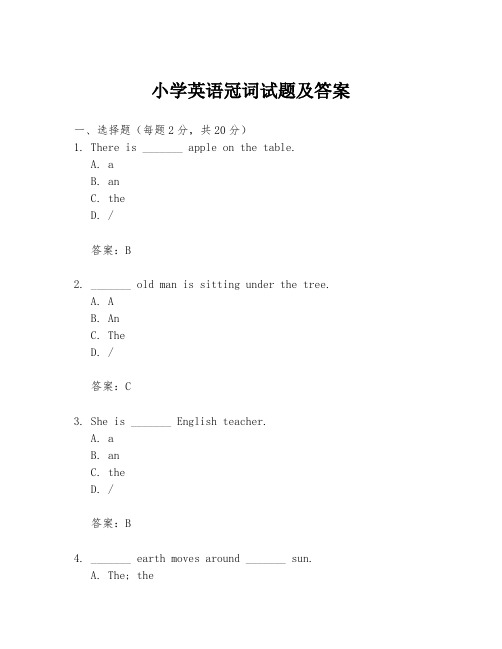
小学英语冠词试题及答案一、选择题(每题2分,共20分)1. There is _______ apple on the table.A. aB. anC. theD. /答案:B2. _______ old man is sitting under the tree.A. AB. AnC. TheD. /答案:C3. She is _______ English teacher.A. aB. anC. theD. /答案:B4. _______ earth moves around _______ sun.A. The; theB. A; aC. The; aD. /; the答案:A5. There are _______ birds in the sky.A. aB. anC. someD. /答案:C6. _______ elephant is the largest land animal.A. AB. AnC. TheD. /答案:C7. This is _______ interesting book.A. aB. anC. theD. /答案:B8. _______ moon is very bright tonight.A. AB. AnC. TheD. /答案:C9. She has _______ umbrella.A. aB. anC. theD. /答案:A10. _______ children are playing in the park.A. TheB. AC. AnD. /答案:A二、填空题(每题2分,共20分)1. There is _______ "s" in the word "island".答案:an2. _______ Great Wall is a famous place in China.答案:The3. _______ boy over there is my brother.答案:A4. She plays _______ piano every day.答案:the5. _______ United States is a big country.答案:The6. _______ cat is sleeping on the sofa.答案:The7. _______ river flows into the sea.答案:A8. Do you have _______ dictionary?答案:a9. _______ sun rises in the east.答案:The10. _______ teacher told us an interesting story.答案:The三、改错题(每题2分,共20分)1. A cat is sleeping in the box. (把A改为An)答案:An cat is sleeping in the box.2. She has a university degree. (把a改为a)答案:She has a university degree.3. The children are playing with the ball. (把the改为the)答案:The children are playing with the ball.4. An hour has sixty minutes. (把An改为A)答案:A hour has sixty minutes.5. The earth is round. (把The改为A)答案:A earth is round.6. There is a book on the table. (把a改为an)答案:There is an book on the table.7. I have the key to the door. (把the改为the)答案:I have the key to the door.8. A university is a place of learning. (把A改为An)答案:An university is a place of learning.9. She plays the violin. (把the改为the)答案:She plays the violin.10. There is an hour before the meeting. (把an改为a)答案:There is a hour before the meeting.四、翻译题(每题5分,共30分)1. 桌子上有一个苹果。
- 1、下载文档前请自行甄别文档内容的完整性,平台不提供额外的编辑、内容补充、找答案等附加服务。
- 2、"仅部分预览"的文档,不可在线预览部分如存在完整性等问题,可反馈申请退款(可完整预览的文档不适用该条件!)。
- 3、如文档侵犯您的权益,请联系客服反馈,我们会尽快为您处理(人工客服工作时间:9:00-18:30)。
小学定冠词the的练习题概说1.冠词是一种虚词,不能独立担任一个成分,只能附着在一个名词上,帮助说明其词义。
英语中有两个冠词:1)定冠词the2)不定冠词a/an定冠词the通常读作[],在元音前读作[i],特别强调或单念时读作[i:]。
不定冠词在元音音素开始的单词前用an这个形式,读作[n];在其他情况下则使用a,读作[]。
2.冠词的基本意义不定冠词a/an与数词one同源,表示“一个”的意思,用在可数名词单数前。
例如:She is a nurse. 她是个护士。
He is an Englishman, with an Irish wife.他是一位英国人,有一个爱尔兰妻子。
定冠词the,与this同源,有“这个”的意思,但比较弱,表示一个特定的人或东西,有时可译作“这个”或“那个”。
例如:That’s the book you want. 这就是你要的那本书。
Who’s the young man over there? 那边那个年轻人是谁?但在很多情况下,“这”或“那”这类词在译文中并不出现。
例如:Put it on the table. 把它放在桌上。
Shut the door, please. 请把门关上。
3.特指和泛指一般来说,名词有特指和泛指两种情况,请比较下面的句子:A gentleman is asking to see you. 有位先生要求见你。
Ask the gentleman to come in. 请那位先生进来。
在特指时一般前面要加定冠词,而泛指时则有三种情况: 1)在可数名词单数前加不定冠词。
例如:She sent me a postcard 她寄给我一张明信片。
2)在可数名词复数前可不加冠词,可使用some, any 这类词。
例如:These are new words. 这些是生词。
She sent me some flowers. 她送给我一些花。
3)在不可数名词前多不加什么,有时也可加some, any等。
例如:It’s lovely weather. 天气真好。
Do you want any sugar in your tea? 你茶里要放点糖吗?Give us some help. 给我们一些帮助。
不定冠词的基本用法1.泛指某一类人或事物中的一个,代表某一类别如: His father is a doctor. 他父亲是医生。
2.代表某一类人或事物,相当于any 如: A horse is a useful animal. 马是有用的动物。
3.指某人或某物,但不具体说明何人或何物如:This book was written by a worker. 这本书是一位工人写的。
4.表示数量,有“一”的意思,但数的概念没有one 强烈如: Wait a moment. 等一下。
5.表示单位,相当于“每”的意思如: We have three meals a day. 我们每日吃三餐。
6.用于某此固定词组中例如:a few, a little, a bit , a lot of等。
定冠词的基本用法1.特指某人或某事物如: Give me the book. 把那本书给我。
2.指谈话双方都知道的人或事物如: Where is the doctor? 医生在哪儿?3.再次提到上文提到过的人或事物如:I bought a dictionary yesterday. The dictionary is at home.昨天我买了一本词典。
词典在家里。
4.用在大家所熟悉的、世界上独一无二的事物如: The earth is bigger than the moon, but smaller than the sun.地球比月亮大,但比太阳小。
5.用在序数词和形容词最高级前如: Mr Wang teaches the first class. 王先生上第一节课。
Of all the stars the sun is the nearest to the earth.在所有的恒星中,太阳离地球最近。
6.用在单数可数名词,表示某一类人或事物如:The horse is a useful animal. 马是有用的动物。
7.与下列专有名词连用1)在江、河、湖、海、群岛、山脉的名称前如: the Changjiang River, the Great Lake2)在姓氏的复数名词前,表示夫妇二人或全家人如: The Greens are sitting at the breakfast table. 格林一家人正围坐在早餐桌旁。
8.和某些形容词连用,表示一类人如: the old 老人 the young 年轻人the rich 富人 the poor 穷人the sick 病人 the dead 死人9.在一些习惯说法中the eastin the morningon the leftin the endgo to the cinema不用冠词的几种情况1.在专有名词,抽象名词和物质名词前如: Have you ever been to Shanghai? 你到过上海吗?We love science. 我们爱好科学。
2.在表示一类人或事物的复数名词前如: Girls can be scientists. 女孩子可以当科学家。
3.在季节、月份、星期、一日三餐的名称前如: It is hot in summer. 夏天天气热。
It’s Tuesday, August the2nd. 今天是八月二十二日,星期三。
Have you had breakfast? 你吃过早饭没有?4.称呼语或表示头衔,职务的名词前如: What’s the matter with you, Mike? 怎么啦,迈克?He is headmaster of our school. 他是我们学校的校长。
5.学科和球类运动的名称前如: We study English. 我们学习英语。
Do you like to play football? 你喜欢踢足球吗? 6.名词前已有用作定语的this, that my, your, some, any, no, whose, every, each等代词时,不用冠词如: That is her bike.那是她的自行车。
Each student in his class studies hard. 这个班的每个学生都努力学习。
7.在某些固定词组的名词前如: at home, at night, after school, by bus, in bed, in town, in front of, go to school, go to bed等。
小学定冠词和不定冠词练习题1.在空格内填上a或an1. _____ear .______actor . _____hen4. ______toy5. ______university6. ______elephant7. ______hat .______umbrella.______rabbit10.______idea 11.______hour 12_______ honest boy13.______interesting book 14.______easy question15.______orange dress 16_______apple pie17_______X-ray machine18.______ice cream2.用a,an,the或“/”填空1.________Washington is _______capital of ________United States of America.2.There is _________”A” on his paper.3. I ate ______apple .It’s _______red apple.4._______tall man over there is my boss. sun.6.No news is ________good news.Great Wall? football after school.attention.sky? tallest in our class.12.Did you have13.Mr.White will go to air.14.By old woman in glasses?3.选择填空 old story every night.A. aB. /C. anD. the computer on the table is Susan’s.A. AB. AnC. TheD. / wall. A. a, a, AB. a, the, TheC. the, the, The D. the, the, A floor.A. /, threeB. A, thirdC. The, thirdD.The, the third winter.A. /, /B.The, /C.The, theD.A, the shoes yesterday. A. a, TheB. a pair of, The C. the, The D.a pair, The pair soldier in the Second World War.小学定冠词和不定冠词练习题1.在空格内填上a或an1. _____ear .______actor . _____hen4. ______toy5. ______university6. ______elephant7. ______hat .______umbrella.______rabbit10.______idea 11.______hour 12_______ honest boy13.______interesting book 14.______easy question15.______orange dress 16_______apple pie17_______X-ray machine18.______ice cream2.用a,an,the或“/”填空1.________Washington is _______capital of ________United States ofAmerica.2.There is _________”A” on his paper.3. I ate ______apple .It’s _______red apple.4._______tall man over there is my boss. sun.6.No news is ________good news.Great Wall? football after school.attention.sky? tallest in our class.12.Did you have13.Mr.White will go to air.14.By old woman in glasses?3.选择填空 old story every night.A. aB. /C. anD. the computer on the table is Susan’s.A. AB. AnC. TheD. / wall. A. a, a, AB. a, the, TheC. the, the, The D. the, the, A floor.A. /, threeB. A, thirdC. The, thirdD.The, the third winter.A. /, /B.The, /C.The, theD.A, the shoes yesterday. A. a, TheB. a pair of, The C. the, The D.a pair, The pair soldier in the Second World War.A. aB. anC. theD. / .A. the tennis, the guitarB. tennis, guitarC. the tennis, guitarD. tennis, the guitar clouds in the sky.A. the, aB. a, aC. the, /D. the, the “c” is in “cat.”“s” is in “sat.”A. An, AnB. An, AC. A, AD. A, An Tian’anmen Square is inA. /, /B. A, /C. The, /D. /, the12.—nearest bookshop?—Go straight and turn right at_______third crossing, and you will seeit.A. the, aB. the, theC. a, theD. the, /冠词重点知识归纳及讲解概说1.冠词是一种虚词,不能独立担任一个成分,只能附着在一个名词上,帮助说明其词义。
